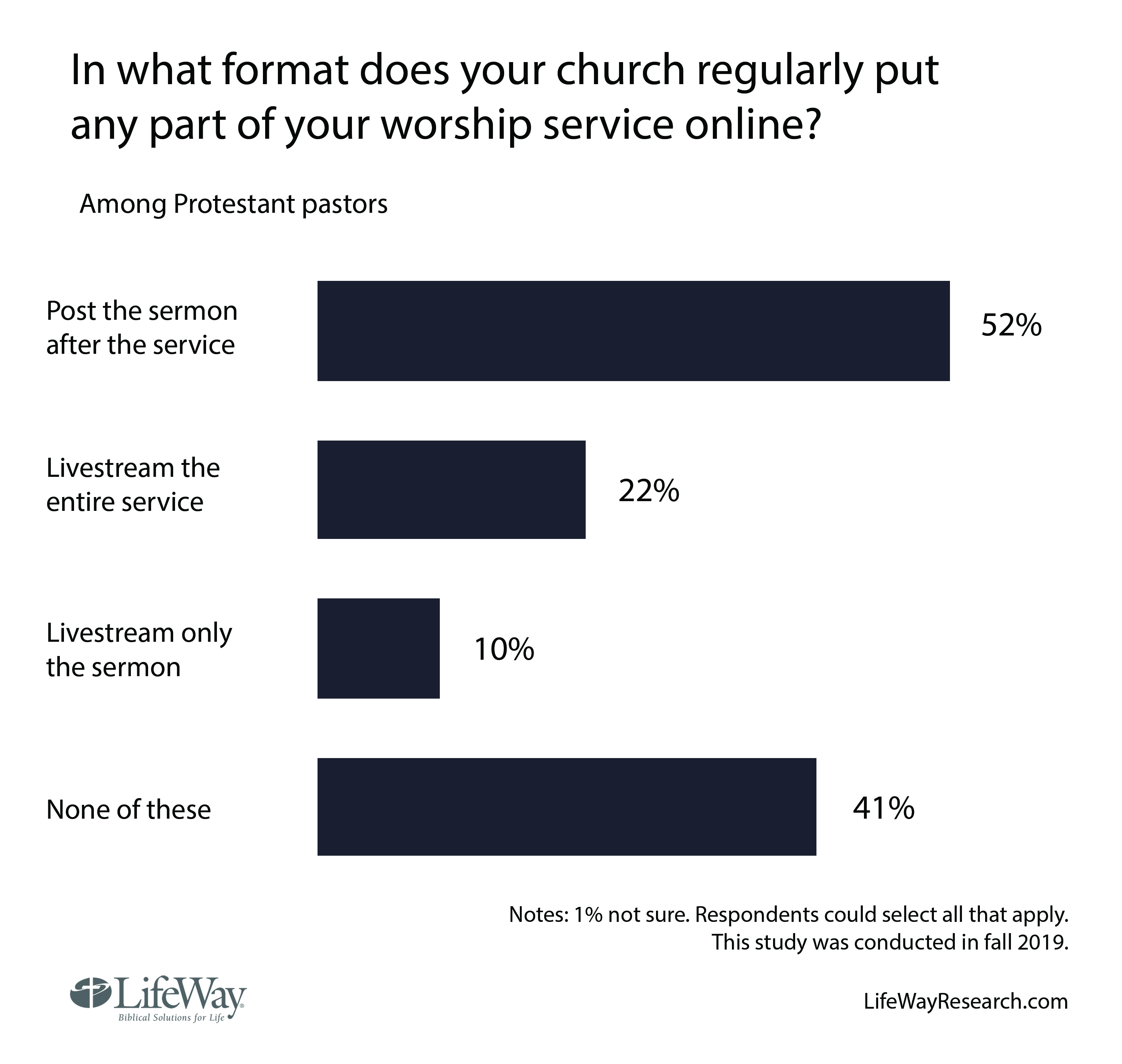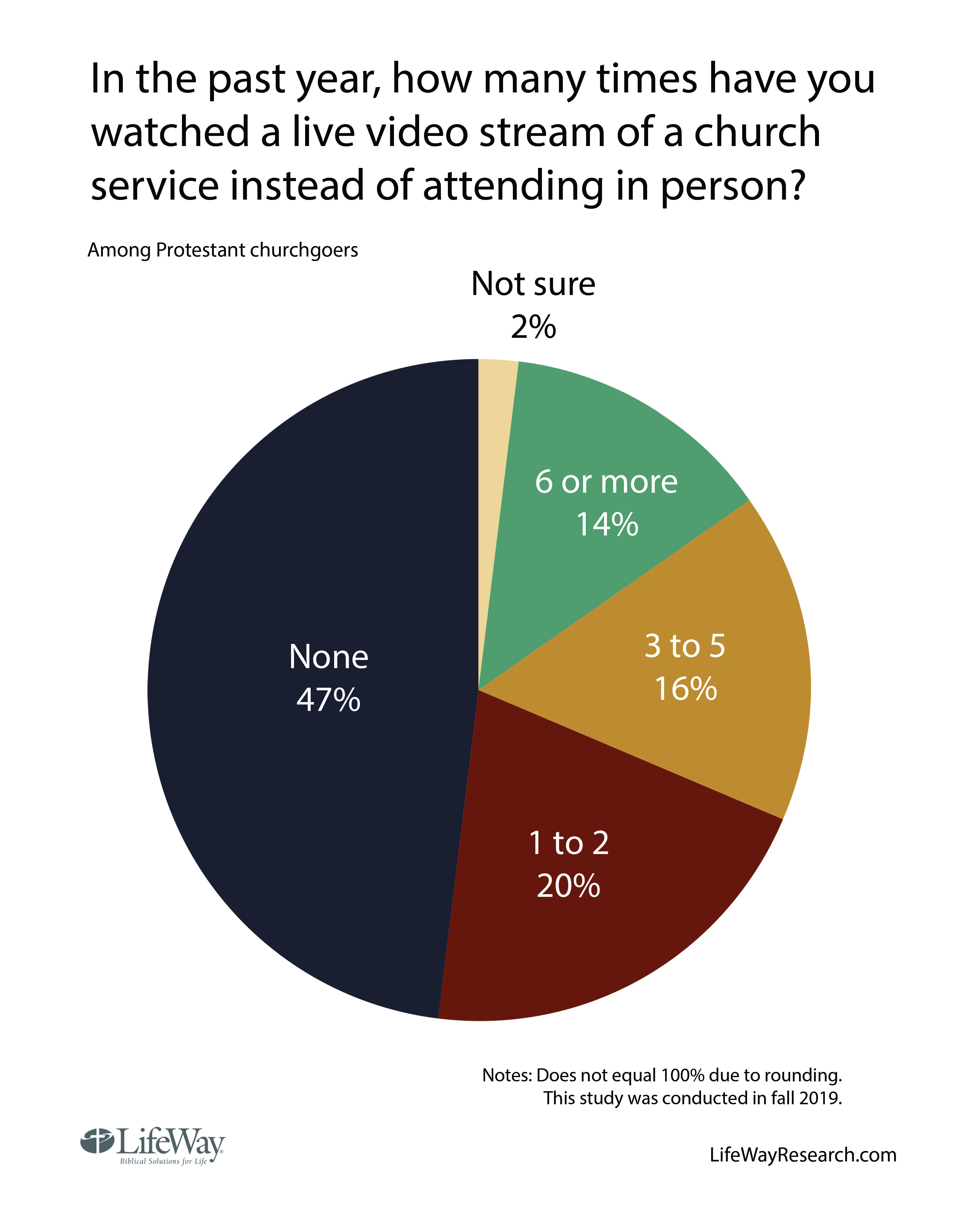 [1]
[1]NASHVILLE, Tenn. (BP) — The latest Centers for Disease Control and Prevention (CDC) guidance [2] for groups during the COVID-19 coronavirus outbreak recommended no gatherings of more than 50 people for eight weeks. As churches scramble to make decisions on how to move forward, new research finds many congregations are not prepared to shift their services online.
 A study from Nashville-based LifeWay Research [3] conducted last fall found 41 percent of pastors say they don’t put any portion of their church service online for people to view.
A study from Nashville-based LifeWay Research [3] conducted last fall found 41 percent of pastors say they don’t put any portion of their church service online for people to view.
Around half (52 percent) say they post the sermon online after the service is over, while 22 percent say they livestream the entire service and 10 percent say they livestream only the sermon.
“As new technologies have emerged, churches have placed their primary weekly worship service online in much the same way they did with radio and television,” said Scott McConnell, executive director of LifeWay Research.
“However, instead of only a few churches in each city broadcasting their service, online and streaming are economical enough for churches of all types to take advantage of the medium.”
In a related survey conducted last year, half of Protestant churchgoers (50 percent) say they watched a livestream in place of in-person church attendance at least once in the past year.
Of those who watched a livestream of their church service instead of attending in person, 2 in 5 (40 percent) say they did so once or twice. Around 1 in 3 (32 percent) say they did three to five times. Fewer did so six to 11 times (13 percent), 12 to 17 times (6 percent), or 18 times or more (9 percent).
Slightly less than half of all Protestant churchgoers (47 percent) say they haven’t watched a church service through a livestream as a replacement for in-person attendance in the past year. Two percent are not sure how many times, if any, they used livestreaming as a replacement.
Those who are part of smaller congregations are more likely to say they haven’t livestreamed a church service. Those who attend a church of fewer than 50 people (57 percent), 50 to 99 attendees (45 percent), and 100 to 249 attendees (53 percent) are more likely to say they didn’t stream any church services last year than those who attend a church of 500 or more (31 percent).
 This may be explained in part by smaller churches being less likely to place any of their services online. Pastors of Protestant churches with fewer than 50 people (69 percent) and those with 50 to 99 (48 percent) are more likely than pastors of churches with 100 to 249 (28 percent) and those with 250 or more (10 percent) to say they don’t regularly put any of their worship service online.
This may be explained in part by smaller churches being less likely to place any of their services online. Pastors of Protestant churches with fewer than 50 people (69 percent) and those with 50 to 99 (48 percent) are more likely than pastors of churches with 100 to 249 (28 percent) and those with 250 or more (10 percent) to say they don’t regularly put any of their worship service online.
“If they need to, almost a third of churches can gather virtually this week using technology and processes they already have in place,” said McConnell.
“Half of churchgoers have recent experience livestreaming a church service. And churches impacted first by CDC’s COVID-19 mitigation guidelines — those with attendance above 250 — are most prepared to provide their service online.”
Male churchgoers (55 percent) are more likely than female churchgoers (41 percent) to say they haven’t streamed a church service instead of attending in person in the past year.
Younger churchgoers, 18- to 34-year-olds (33 percent) and 35- to 49-year-olds (39 percent), are less likely to say they haven’t watched a livestream of a church service in the past year than older churchgoers, 55- to 64-year-olds (54 percent) and those 65 and older (62 percent).
A valid replacement?
Both Protestant pastors and churchgoers see some reasons for streaming a worship service as more valid than others.
A majority of pastors say viewing a live online video stream of a local church’s worship service is a valid replacement for physically attending church when sick or caring for someone who is sick (83 percent), a non-attendee wants to know more about the church or its teaching (77 percent), and when traveling (63 percent).
Fewer pastors believe replacing physical attendance with online streaming is valid whenever someone wants (38 percent).
Among churchgoers, majorities see watching online as a valid replacement when someone is sick or caring for another (76 percent) and when traveling (60 percent).
Fewer believe livestreaming services is an acceptable alternative when you live too far away to attend (45 percent) or get up late (36 percent).
Churchgoers are less likely than their pastors to believe livestreaming a service is a valid replacement when a non-attendee wants to know more about the church or its teaching (32 percent) or simply whenever someone wants to watch online instead of physically attending church services (27 percent).
There may be confusion among churchgoers about when streaming is acceptable or not because even at churches where streaming is an available option, many pastors have never told their congregation what they think about it.
Slightly more than half (55 percent) of Protestant pastors who regularly livestream at least part of their service say they have communicated their views on livestreamed services to their church, while 45 percent say they haven’t.
“Current health concerns give churchgoers another reason to take advantage of remote attendance,” said McConnell. “The long-term question is whether churches can convince viewers there is more to church than just video content on a screen.”
Methodology:
The phone survey of 1,000 Protestant pastors was conducted Aug. 30 – Sept. 24, 2019. The calling list was a stratified random sample, drawn from a list of all Protestant churches. Quotas were used for church size.
Each interview was conducted with the senior pastor, minister or priest of the church called. Responses were weighted by region to more accurately reflect the population.
The completed sample is 1,000 surveys. The sample provides 95 percent confidence that the sampling error does not exceed plus or minus 3.3 percent. Margins of error are higher in sub-groups.
The online survey of 1,002 American Protestant churchgoers was conducted September 20-27, 2019 using a national pre-recruited panel.
Respondents were screened to include those who identified as Protestant or non-denominational and attend religious services at least once a month. Quotas and slight weights were used to balance gender, age, region, ethnicity and education to more accurately reflect the population.
The completed sample is 1,002 surveys. The sample provides 95 percent confidence that the sampling error from the panel does not exceed plus or minus 3.2 percent. Margins of error are higher in sub-groups.
For more information on this study, visit LifeWayResearch.com [3] or download the complete pastors [5] and churchgoers [6] reports.
